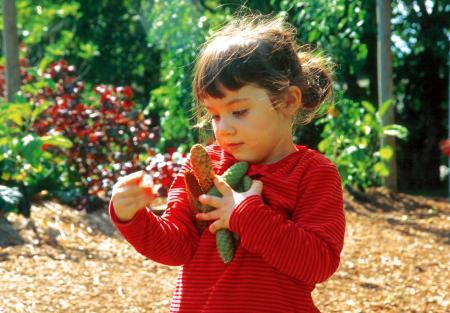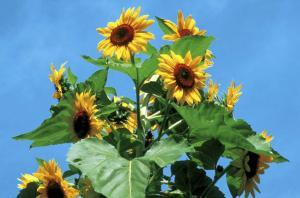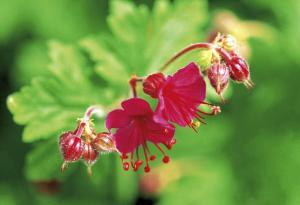A pocket full of miracles
By Theresa M. Forte
 |
Surprisingly, with just a little imagination, there is plenty to keep them occupied while the grownups have a relatively calm visit, and these activities can easily be transferred into clients' gardens for visitors of all ages to enjoy.
Armed with empty plastic slide boxes and boundless enthusiasm, the children set out on a scavenger hunt. At first, I suggested they scour the garden to find leaves that smelled like lemon. They were intrigued. How could a leaf smell like a lemon? Away they scurried, full of purpose, returning every few minutes with possible candidates, each plucked with surprising gentleness from the parent plant. A number of plants with yellow flowers were chosen by the youngsters, they associated yellow flowers with lemon fragrance, even though none of them offered the slightest lemon scent. I offered a hint, "What would happen if you rub the leaf of this Melissa plant and then sniffed the bruised leaf?" Ah, lemon! They eventually discovered four lemon-scented plants in the garden: lemon verbena, lemon balm (Melissa), lemon thyme (Thymus x citriodorus) and bigroot geranium (Geranium macrorrhizum). The youngsters were hooked and eager to learn more about the garden.
|
The next activity was to search for seeds. This sounded easy enough. But seeds are packaged in all sorts of unusual wrapping in the garden. The youngsters knew that the seed should be close to a flower, but where? This was one activity that required a little adult help, so we set out to harvest seed heads together. We collected four seed samples per trip, a different one for each of my young scavengers. The late July garden is a surprisingly rich hunting ground for seeds with many early blooming perennials and self-seeding annuals having completed their blooming cycles.
Our first choice was a rounded, fat pod filled with dry poppy seeds. (You will notice, I am now part of the exploration team, it's hard to sit still with all of this fun stuff going on!) A gentle shake, Emily thought they sounded like maracas! The sturdy pods sound like a tiny rattle and resemble a saltshaker in design. A star shaped cap covers a series of tiny openings that release the fine, sand-like seeds when the pod is turned upside down. Each pod holds more seeds than we could count. Next, we dissected the spent flower of a marigold. Long, slender seeds were neatly packed like arrows in a quiver. This seed did not even resemble the tiny poppy seeds we had just collected. What other seeds could we find? The papery brown seed heads of a nearby columbine attracted their attention next. The young botanists were starting to understand what to look for. Columbines offer their seed in long, vase shaped vessels. A ripe pod is flared open and remarkably elegant despite its dull colouring. Each pod is made up of five long cylinders, each filled with tiny black pellets of seed. The variety of packaging and diversity of seed shape and size was of great interest to the children. Our next find was bundles of mallow seed. These seed heads resemble tiny packages, neatly wrapped in parchment paper. To open the circular package, you must gently fold back each pointed section of the covering. Inside, the crescent-shaped seeds are neatly packed around a taller stem. (Unless you have remarkable eyesight, a magnifying glass will work wonders here.) Cranesbills offered another unusual package for the delivery of seed. Each seedpod resembles a tiny candleholder, complete with a tiny candle and miniature red flame. At the base of these candles are five perfect little seeds, each wrapped in its own paper-like protective coating. When the time is right, these seeds will be sprung free to make their way to the far reaches of the garden. By now the youngsters were eager to search for their own unique seedpods. Dianthus offered seed in tiny shakers similar to those of the poppy, but without the caps. Hollyhocks presented seed in a package similar to that of their cousin, the mallow. How quickly the youngsters were learning! Collections of seed filled the slide boxes ready to be taken home for planting. As we finished labeling the boxes, the youngsters were proudly showing their collections to interested parents, their recall of plant names was surprisingly accurate. Parents seemed enthusiastic about including these collections in the garden at home, even to the point of encouraging the young explorers to see if the coneflowers had any seed just yet. It would appear the grownups were catching the gardening bug as well. Boxes of seed were tucked safely away for the trip home, each a pocket full of miracles! Theresa M. Forte is a columnist, photographer and garden consultant based in Niagara Falls, Ont. |


